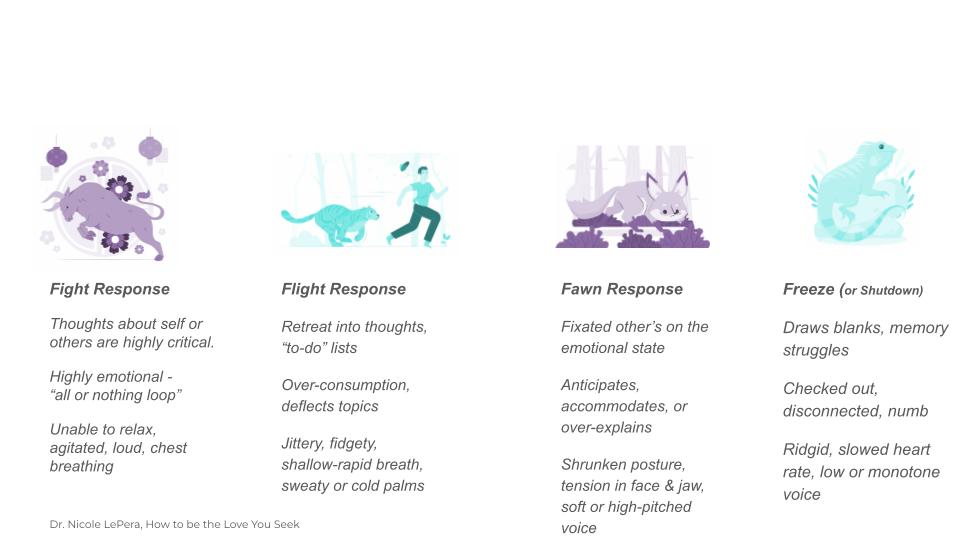Before I go further, I want to acknowledge my perspective, as a cis gender, straight, white, middle age woman. Just as any of us, I can only speak from my perspective and experiences. I try to do this with authenticity, integrity, and empathy. Also, there are many, very legitimate reasons why people are afraid. They rightfully feel unheard, unseen, unvalued and marginalized. These are real and profound fears. These are not the fears I’m speaking of in this article – although, I do believe that some of the fears I’m writing about have led to the reasons why people have these sincere fears. Also, as with anything I write, if this is not for you, then it’s not for you. But I hope you’ll read with an open mind and open heart.
Values – and living out your values – is kind of my jam. My top three values are Community, Creativity, and Harmony. When one of these is threatened, I feel threatened, and when I am afraid, I turn to my natural instincts of fight or flight – I lash out or I shut down. And, while I know each mode has their protective nature, I also know that this enables the fear cycle: you perceive the threat, you fear something unpleasant from the threat, your body responds, you avoid the threat, you lose confidence, you become more afraid, and more fear is born.
When we fear, we stop growing.
To better understand fear, it’s good to know how we as individuals react when we are afraid (stressed, anxious, etc.). We all know the terms fight or flight, but other standard fear responses include fawn and freeze. My awesome friend and BRA colleague (see the newsletter for more on the BRAs), Eileen Murphy of Blackbird Life Coaching, created this fantastic illustration of different fear responses. Before we go further, take a look and do some reflection. What’s your response type? I know that I go back and forth between fight – when there’s an urgent situation, I quickly shift into fight mode – and flight – when it’s a longer term, slow burn situation, I shut down, feeling isolated and disconnected from others.

Meta Fear vs. Mega Fear
I think of fear in many ways, but for this article, I’m focusing on what I call Meta Fear and Mega Fear. Meta Fear is the internal dialogue telling us why we should fear things like change or trying something new. This is different from our gut instincts that warn us of real danger. Meta Fear is the voice keeping us in our place, digging us deeper in that comfort zone and bullying us into a metaphysical slumber. It tells us, “Don’t try that new thing, people might laugh at you,” or “You don’t want to learn more about that, you’re not smart enough.” Meta Fear might sound like us, or a teacher, or parent, or kid on the playground. It speaks down to us, rationally telling us we aren’t worthy of growth. The more we listen to it, the more we fear, and under the weight of this, we stop trying, becoming stagnant and insular, and feeling weak and powerless.
In my work with clients who have recently gone through a layoff, they often want to make a big change during this transition – they want to go for the next title, or redefine their career, or hold out for THE company or opportunity. But then fear creeps in, which is fair (paychecks are necessary). They begin to fear they won’t find any job, let alone THE job, they fear for their family if they don’t have a steady income, they fear what others think of them if it takes them a while to land in their next role. The fear cycle takes hold and they begin to fear they weren’t good enough at their previous job and that’s why they were cut – instead of the real reason of leadership transitions or budget constraints. They begin to sabotage their search by applying to lower paying / titled roles or misspeaking in interviews because they are afraid they won’t get this one opportunity. In this space of survival, it’s hard to dream, to think outside the box, or to grow.
These fears are real, and yet, getting stuck in the fear cycle, doesn’t get us to where we want to be – where we’ll truly flourish. That’s what fear does, it creeps in like a fog, so slowly we don’t realize when we are in it. We can’t see in front or behind us, where we want to go or where we came from, and we feel stuck and static. When you are in the fog of fear, you are limited, you stop being creative and you stop growing. And, worst of all, we stop trusting our own voice and wisdom.
The more we fear our own voice, the more we misplace trust in ourselves and instead listen to the loudest noise around – and that leads to Mega Fear.
Mega Fear is the fear we internalize from loud outside noises such as news outlets, social media, or the loudest voice in any space. Mega Fears tell us to be afraid without providing proof as to why we should fear. Mega Fear speaks to us on a mega level – not a meta or individual level, often in blanket statements and one size fits all sound bites. It might make us believe something is a threat that isn’t or that something is larger than it actually is. Mega Fear feeds on perceived differences – I “should” be afraid of this because it’s different from me. I know I’m not alone in believing that a lot of Mega Fear right now is what is causing real fear for individuals who feel unheard, undervalued, marginalized and in real fear for their safety and well being.
I heard Emily Drabinski, former president of the American Library Association, speak with Bill Ayers on the podcast Under the Tree: A Seminar on Freedom with Bill Ayers. Throughout her tenure, she visited 60 libraries all over the country – small towns and big cities alike – as an openly queer woman. Her national tour was happening at the same time the Mega Fear voices were rallying about book banning, yet, on her tour, she only encountered one protest, and it included 2 people with one sign. Instead of the Mega Fear anthem of fear what and who we don’t know, she found people open to collaboration, being creative with resources and welcoming her with open arms. Mega Fear doesn’t always speak in truth, it’s up to us to listen for the real truth.
Earlier I mentioned that my three core values are Community, Creativity, and Harmony – and I get to define these words and what they mean to me. I also get to perceive what I see as threats to these values – and I perceive a lot of Mega Fear threats to these values currently. But, I also see people working towards a common good, people helping each other, people learning so they better understand what’s at stake and how to speak up. I see people every day coming out of their fear cycle, and stepping away from their Meta Fear to protect what’s important to them.
Combating Fear with Nourishment and Connection
Every year at Halloween I’m struck by the number of Trunk-or-Treat events. Now, I’m here for a fun fundraiser and candy, but I am always dismayed when I hear people say they’re a “safe” alternative to traditional trick-or-treating. To my article last month on connection, many of us don’t know our neighbors like the generations before us did – and, isn’t that a shame? Traditional Trick-or-Treating would be a great way to connect with others. What is it that we fear from walking our kids up to our neighbors’ doors for candy? Do they fear us in return? How much of our Meta and Mega Fear is because we’ve lost connection with ourselves and with others? We fear what we don’t know and many of us feel disconnected from ourselves and our values. How can reaching outside our comfort zone actually help us break out of fear?
I recently finished the beautiful and thought provoking book, Diana, Herself: An Allegory of Awakening, by Martha Beck. One of the tasks the main character needs to perform is to learn “to choose what nourishes you, not what poisons you.” Initially this begins with listening to her gut about food in the wilderness, but it expands to non-food decisions. The average adult makes 35,000 decisions a day. How often do we stop to ask if the outcome will nourish us or “poison” us – our mind, body, and spirit? Do we listen to our gut or to our Meta or Mega Fear voices? When we turn on the news or scroll social media, which are we getting? The poison that fuels fear, leading us to ingest more poison, which leads us back to the fear cycle? What could we do instead to nourish ourselves?
I don’t have a way to wrap this up with a pretty bow. But what I do know is that fear thrives in disconnection—disconnection from ourselves, our values, and each other. Meta Fear keeps us small, Mega Fear keeps us divided, and both prevent us from fully stepping into our power. But when we recognize these patterns, we have a choice.
We can choose nourishment over poison. We can choose curiosity over avoidance. We can choose connection over isolation.
Fear may never disappear entirely, but we don’t have to let it dictate our lives. Instead, we can step forward with intention, recognizing fear for what it is – a mindset. When we reconnect with ourselves and our communities, we reclaim our ability to grow, create, and live in alignment with our values.
So, what will you choose today?
Journal Prompts
- What are my top 3 values and how do I define them?
- What is the loud voice that I am allowing to influence me?
- Where is there a lack of connection that is actually based on fear?



